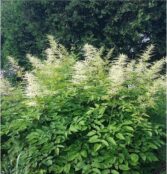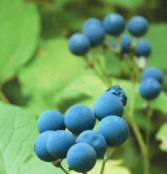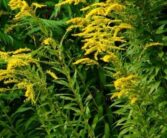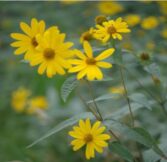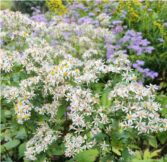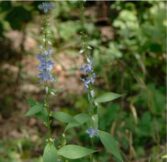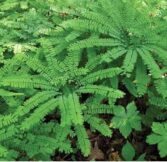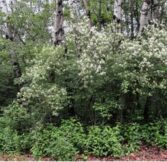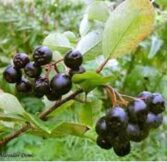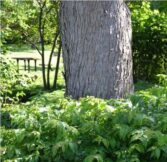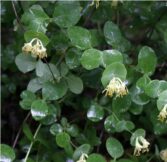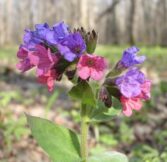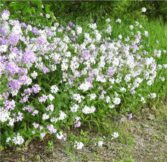Late-Blooming (Summer-Fall*)
Wildflower Plants
An Identification Guide
*grouping is approximate since many bloom times overlap.
The majority of the plants growing in the Wildflower Garden were native to mid-central North America before the arrival of European settlers.
Some species are found throughout the garden, others occur naturally.
Goat's Beard
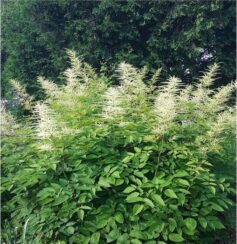
Goat's Beard
Aruncus Dioicus
- Life Cycle: Perennial
- Bloom Time: May-June
- Sun Exposure: Partial, Shade
- Bloom Color: Cream White
Goat's beard, also known as bride's feathers, is a perennial forb in the rose (Rosaceae) family. Native to the northern hemisphere in North America, this plant generally grows in moist woods, meadows, and along streams. It is also known to grow in moist to wet ravines, rocky ledges, and avalanche chutes. Goat's beard is a very showy plant, growing up to six feet tall in large bushy clumps. Feathery clusters of tiny, cream-colored flowers grow on long branched spikes high above the leaves and bloom from late May through mid-July.
Blue Cohosh
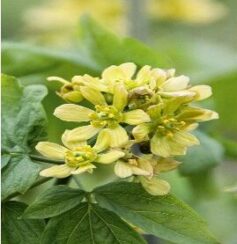
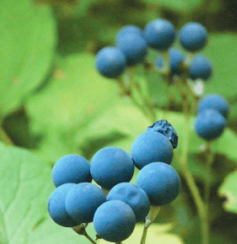
Blue Cohosh
Caulophyllum thalictroides
- Life Cycle: Perennial
- Bloom Time: April-June
- Sun Exposure: Partial, Shade
- Bloom Color: Blue, Green
Blue Cohosh is a choice woodland native, treasured for its lacy blue-green foliage and deep blue berries. This beautiful shade garden plant prefers a soil with abundant organic matter from decaying leaves and consistent moisture. In spring, a cluster of yellow flowers appear at the branching "Y" of the stem. The flowers are intricate and interesting, but small and somewhat inconspicuous. The berries that follow, however, are very showy. Starting out green, the berry clusters turn blue as they mature later in the summer. In fall the berries persist as the plant foliage turns bright green-gold. Combine this shade-loving species with lower growing wildflowers.
Zig Zag Goldenrod
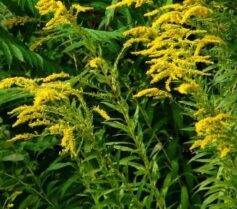
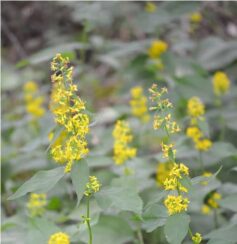
Zig Zag Goldenrod
Solidago flexicaulis
- Life Cycle: Perennial
- Bloom Time: August-October
- Sun Exposure: Partial, Shade
- Bloom Color: Yellow
Zig Zag Goldenrod gets its name from the way that its stems "zig zag" from leaf to leaf. These leaves are bluntly toothed all along the stem with the middle leaves usually the largest at 6" long and 4" wide. The small flowers appear from late summer to early fall in a cluster near the top of the plant. Zig Zag Goldenrod can be aggressive. Sadly, goldenrods often get blamed for causing the dreaded hayfever. This is simply not true. Their pollen is quite large and sticky so as to better adhere to the body of visiting insects. Because of this, goldenrod pollen cannot become airborne and can never make its way into your sinuses. We cannot stress enough how important goldenrods are on the landscape.
Woodland Sunflower
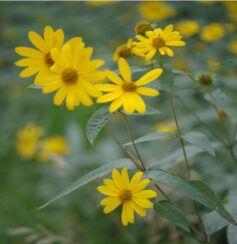
Woodland Sunflower
Helianthus divaricatus
- Life Cycle: Perennial
- Bloom Time: July-September
- Sun Exposure: Partial, Shade
- Bloom Color: Yellow
Woodland Sunflower, Helilanthus divaricatus, features 2-inch wide flowers with bright yellow rays and slightly darker yellow centers, blooming from midsummer to fall. Tolerant of a wide range of soil conditions, it is easily grown in average, dry to medium well-drained soil in part shade, and is especially suitable for dry, open woodland or savanna. Over time, it will spread to form colonies and may not be suitable for smaller planting areas. Divide it every 3-4 years to control spread and maintain vigor.
Woodland Aster

Woodland Aster
Aster divaricatus
- Life Cycle: Perennial
- Bloom Time: August-September
- Sun Exposure: Partial, Shade
- Bloom Color: White
White Woodland Aster (Aster divaricatus) is one of the first asters to bloom, brightening up the shade garden from late summer into fall. Numerous small daisy-like flowers with white petals and yellow centers are borne in loose clusters at the ends of the stems. Typically around 3’ feet high with an upright habit and spreading branches, the stems are slender and often reddish in color. The dark colored stems contrast beautifully with the white flowers, and the deep green foliage looks great all season.
Bishop's Cap
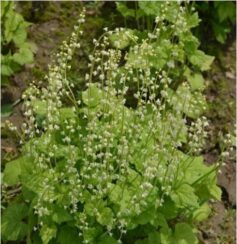
Bishop's Cap
Mitella diphylla
- Life Cycle: Perennial
- Bloom Time: April-June
- Sun Exposure: Partial, Shade
- Bloom Color: White
You'll fall in love with the tiny snowflake-like, fringed flowers atop the thin stems of Bishop's Cap. Other easily identifiable characteristics include a single pair of leaves half way up the stem (hence the species epithet "diphylla," or "two-leaves"). The name Bishop's Cap refers to the seed capsules, which are split open to resemble the deep cleft in a bishop's miter. The upright capsules are designed for a type of seed dispersal known as splash-cup dispersal. When raindrops strike the capsule, the splash sends seeds flying up to a meter away. Bishop's Cap can tolerate drier full shade sites, although its preference is for medium soils and partial sun in the spring months.
American Bellflower
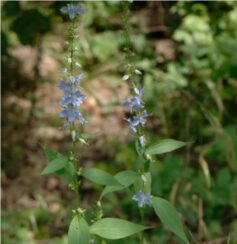
American Bellflower
Campanula americana
- Life Cycle: Biennial
- Bloom Time: July-October
- Sun Exposure: Partial, Shade
- Bloom Color: Blue
Tall Bellflower, or American Bellflower, reaches from three to five feet in height, its blue-violet blooms providing a bright late-summer accent to savanna or woodland plantings. Self-seeding, it is either annual or biennial by habit, seemingly depending on when germination occurs. First-year plants are tight rosettes of heart-shaped leaves that shoot up the following spring to form tall stems. Because Campanula americana is the only bellflower with wide-spread petals, a petal tube that elongates with age and stamens that extend over the petals, it often is assigned the special designation Campanulastrum americanum.
Northern MaidenHair Fern
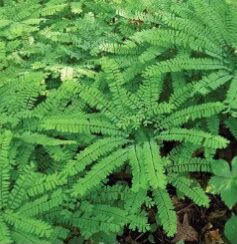
Northern MaidenHair Fern
Adiantum pedatum
- Life Cycle: Perennial
- Sun Exposure: Partial, Shade
The fine textured foliage of MaidenHair Fern (Adiantum pedatum) provides a perfect foil for other plants in the shade garden. Unique among ferns, the gently arching fronds seem to float suspended above the ground in a graceful fan-like shape. The floating illusion is maintained by a structure of very fine black stems that all but disappear against the background. Highly recommended for home landscaping Maidenhair fern is easy to grow, low maintenance, and highly resistant to damage from deer.
Ostrich Fern
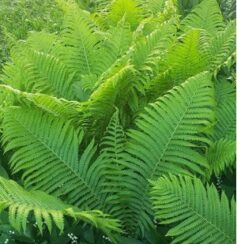
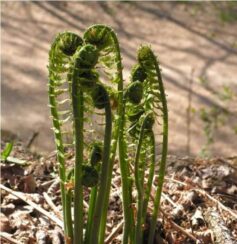
Ostrich Fern
Matteuccia struthiopteris
- Life Cycle: Perennial
- Sun Exposure: Partial, Shade
Large and vase-shaped, with beautifully textured fronds, Ostrich Fern creates acdramatic effect in the shade garden. Excellent for naturalizing, it is a good choice for stabilizing soils along shady stream banks and ravines. While many ferns prefer acid to neutral soils, Ostrich Fern is tolerant of a wider range of soils. In optimal moist conditions Ostrich Fern can spread and form denseccolonies. The emerging fiddlehead shoots are considered a delicacy, when cooked. Ostrich Fern is both, deer and rabbit resistant.
Grey Dogwood Bush
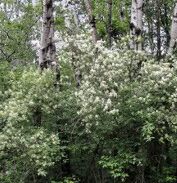
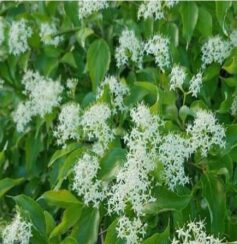
Grey Dogwood Bush
Cronus racemosa
- Life Cycle: Spring, Summer
- Sun Exposure: Partial, Shade
- Mature Height: 6-8 feet
Grey dogwood is a gray-stemmed native shrub that is excellent for naturalizing, especially in difficult sites. Although its suckering and spreading habit makes it impractical for formal plantings, it can be incorporated into the shrub border and useful as a mass planting. The Grey Dogwood has a dense, round flower-head that is creamy-white. The flowers develop into white fruits borne on bright red bracts. This plant then transforms come fall, showcasing purple foliage. This shrub adapts to dry and sandy soils.
Witch Hazel Shrub
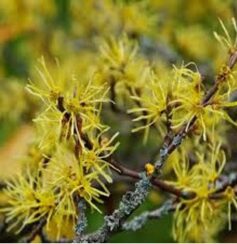
Witch Hazel Shrub
Hamamelis virginiana
- Life Cycle: Perennal
- Bloom Time: October-November
- Sun Exposure: Partial, Shade
- Bloom Color: Yellow
Witch Hazel is an attractive fall-blooming, native, low-maintenance shrub/small tree that grows best in part shade and medium-wet, slightly acidic soils. Its most notable feature is the fall yellow flowers, one of the last to appear, and are very fragrant.
Black Chokeberry Bush

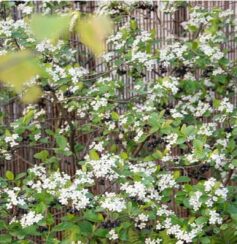
Black Chokeberry Bush
Aronia melanocarpa
- Bloom Time: May-June
- Sun Exposure: Sun, Partial
- Bloom Color: White
Black Chokeberry (Aronia melanocarpa) is graced with an abundance of beautiful white flowers with pink anthers, for several weeks in May. In autumn the vibrant leaf color is a major attraction, with tones of electric orange, red and burgundy. The multi-stemmed form with vase-shaped branching has a rounded top, and the mature size is typically around five or six feet tall.
Native Dwarf Honeysuckle
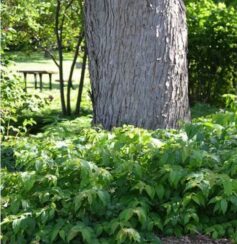
Native Dwarf Honeysuckle
Diervilla lonicera
- Bloom Time: June-August
- Sun Exposure: Partial, Shade
- Bloom Color: Yellow
Honeysuckle Dwarf Bush is a hardy, rugged shrub with dependable yellow summer blooms that redden as they are pollinated. Two plants are needed for pollination, and there's plenty of pollinators out there ready to help out. In fall, the leaves turn lovely shades of red and purple. I often recommend Honeysuckle Dwarf Bush as a low hedge, perhaps lining a driveway.
Grape Honeysuckle
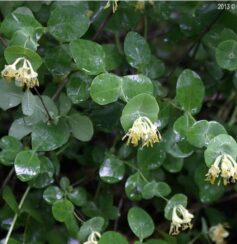
Grape Honeysuckle
Lonicera reticulata
- Life Cycle: Perennial
- Bloom Time: April-June
- Sun Exposure: Partial, Shade
- Bloom Color: Yellow, Pink
Grape honeysuckle is a twining woody vine, sometimes somewhat bushy when no support is present. Native to Iowa woodlands.
Flowers in clusters at the end of stems on new growth; clusters arranged in 2–6 whorls or layers, which are usually separated along the stalk; flowers pale yellow, fragrant, ¾– to 1-inch long, tubular, slender, noticeably enlarged on one side at the base, smooth on the outside, hairy inside; tip of tube strongly spreading into 2 lips, one lip with a single narrow lobe, the other lip with 4 short lobes; stamens protrude beyond flower.
Lungwort Pulmonaria
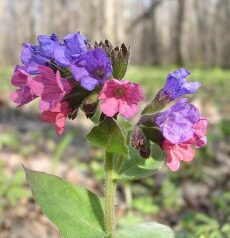
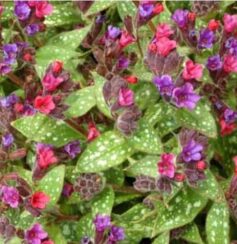
Lungwort Pulmonaria
(non-native)
- Life Cycle: Perennial
- Bloom Time: April-June
- Sun Exposure: Shade
- Bloom Color: Purple, Pink, Blue
Pulmonaria hail from a native range encompassing much of Europe and into Russia. In the wild, they usually grow in deciduous woodlands.The flowers, most of which emerge usually either pink or violet, typically change to blue as they age. The name pulmonaria arose from the foliage, which is often green with white spots, resembling a diseased lung ... hence the common name lungwort.
Lily of the Valley
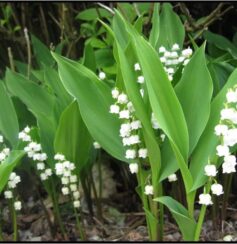
Lily of the Valley
Convallaria majalis
- Life Cycle: Perennial
- Bloom Time: April-May
- Sun Exposure: Partial, Shade
- Bloom Color: White
The stems of lily of the valley plants are covered with tiny white, nodding bell-shaped flowers that have a sweet perfume and medium-bright green leaves that are lance-shaped, 4 to 8 inches and 3 to 5 inches. Though lily of the valley is generally considered to be quite adaptable, the plant does have some specific considerations. Among these is its ability to spread throughout the garden, sometimes becoming invasive. Planting lily of the valley should be done with care, as the manner in which it is able to multiply can become quite problematic.
Dames Rocket

Dames Rocket
Hesperis matronalis
- Life Cycle: Biennial
- Bloom Time: May-June
- Sun Exposure: Full, Partial, Shade
- Bloom Color: White, Purple
[INVASIVE] Dame’s rocket (Hesperis matronalis) resembles phlox in height and color but is in a different plant family entirely, the Mustard family (Brassicaceae) while Phlox is in the Phlox family (Polemoniaceae). Perhaps the most distinguishing difference between the two is that Dame’s rocket has four petals, while phlox has five. While beautiful, dame’s rocket does have an invasive nature as evidenced by the prolific pockets of plants readily seen this time of year. Don't be fooled by the beauty of Dame's rocket. This plant will not make a great addition to Iowa cutting or perennial gardens.

